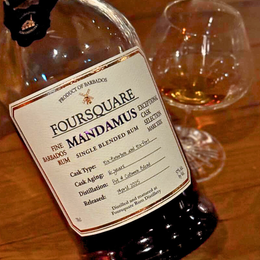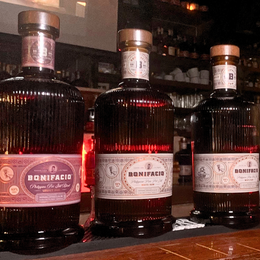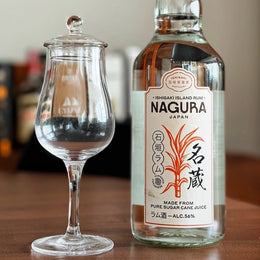Old Cadenhead’s Demerara's: Cadenhead’s XPD 1971 from Enmore Distillery, 61.8% a.b.v. (32 years) & Cadenhead’s GM 1974 from Uitvlugt Distillery, 61.5% a.b.v. (30 years)

Background: a head-to-head between two old continentally-aged demerara rums of great repute. Much has been said of Velier’s contribution to “premium sipping rums” as a market: the proliferation of small batch, single distillery offerings without additives, chill-filtering and dilution. If Velier were considered the Samaroli of demerara rum, then Cadenhead’s is definitely the analogue to Giaccone. In the early 2000s, before Luca Gargano ushered in “the age of Velier’s demeraras”, Cadenhead’s released over a dozen ultra-old, cask strength, continentally aged exemplars of the style. Distilled between the 1960s and the 1970s, they include probably the only commercial bottlings of what is thought to be a Savalle-distilled Port Mourant mark (the 1964 Uitvlugts).
What we have today are two bottlings of 1970s distillate, one from the Versailles still and the other from the Port Mourant still. After being less than impressed by the Velier unicorns I tried, I am approaching this with slight trepidation.
Name: Cadenhead’s XPD 1971 from Enmore Distillery, 61.8% a.b.v. (32 years)
Nose: nicely striated, if not the weightiest; starts out fruity and honeyed; green banana and papaya, then ripe yellow ones; dried prunes; umeshu; stewed and oxidised apples, as if an old calvados; honey and beeswax; a woody and herbal core presents itself soon enough; creamy sandalwood; the mustiness in an old lacquered box; olive brine; malt whisky new make; kvass; monk fruit based herbal tea; then a layer of raw green notes; celery; raw almond; damp forest undergrowth; assorted green herbs – coriander, dill, tarragon; canned spinach; vegetal peat a la Ledaig; grilled seaweed; rich, spicy wood resins; the typical Versailles notes are there too; dried shiitake mushrooms; cigar humidor; liquorice and Chinese liquorice; anise; pencil shavings; wet dunnage and burlap; the oxidative notes of oloroso sherry; hazelnut praline; tar; petrol; cooking gas; base notes of rust, copper coins and wet rocks provide substantial aromatic support.

Palate: full-bodied; metals are the throughline here – the metallic notes form a spine on which the other flavours flourish; brass furniture; steel machinery in industrial grease; rust; then comes the kind of deep, dark notes found in the best sherried whiskies; all kinds of raw honeys; kokuto; toffee and butterscotch; burnt sugarcane; barbecue sauce; raw cacao; herbal jelly; nin jiom pei pa koa cough syrup; a grassiness cuts through the richness, as in old Highland Parks and rhum agricoles; brighter fruit notes guest star, before things get smoky on the back-palate; dry apple cider; dried fruits the likes of papaya, mango, apricot and sultana; mint bubblegum; ground almond; plastics in a smouldering landfill; charred rice crackers; a peppery cigar; coffee grounds; ashy, tarry peat a la Ardbeg; a stemmy, earthy marc; a variety of incense and wood resins, most notably frankincense and balsam.
Finish: long; more incense, followed by powdery tannins to accompany the other aromas; metallicness is still a theme here, this time with the trifecta of salted caramel, salty liquorice and salty mung bean paste (tau sar) so often found on the finish of a Clarendon EMB; apples galore again – juice, cider, brandy, the whole nine yards; liquorice; monk fruit based herbal tea; sarsaparilla drink but more acidic, perhaps a blend with cola; chocolatey, malty grassiness, akin to what one gets after adding Ovaltine to a grass jelly drink; it gets more green and nutty in the aftertaste; celery juice; canned spinach; fresh almond; baked sunflower seeds and flaxseeds; green peas and edamame; finally, refreshing mint bubblegum with hints of plastics and rubber.
Conclusion: as Serge mentioned, one of the great oak-driven spirits, surely. It is uncanny how the wood tannins and demerara colouring combine over time to evoke the flavours and aromas of rich sherry and sherried malts. Add to that, a nigh-perfect integration of the strong distillate character, and we have a real winner. This is unlike the tropical Velier stuff that is rich and intense, yet rounded; there are obvious rough edges here, even some off-notes. Yet, it is no doubt the best demerara rum I have tasted so far.
Score (assuming a normal distribution with mean 50): 93/100
---
Name: Cadenhead’s GM 1974 from Uitvlugt Distillery, 61.5% a.b.v. (30 years)
Nose: less striated, but more acidic and more savoury than the XPD; still a lot of depth here; the top notes are sweet and fruity; dried figs; raisins; maraschino cherry; banana bread; churro; cinnamon sticks; sarsaparilla drink; candied ginger; salted caramel; salty liquorice; varnished wood and chocolate, evocative of some of the best bourbons I ever tasted; earthiness and umami are dialled to eleven in the heart notes; a hint of metallic brine a la blood; vinegars, balsamic and zhen jiang black; various types of soy sauce; mirin; pork floss; beef bouillon; barbecue ribs; burnt ends; charred rice; roasted fatty duck skin with plum sauce; black truffle; sesame and scallion oil; olive tapenade; dried shrimps and scallops; hell, a whole bottle of XO sauce; the base notes include tar, petrol, durian, vehicle exhaust, cooking gas, American ginseng, coffee grounds, pu-er, and petrichor.
Palate: full-bodied, grippy; starts out woody; oak tannins; freshly cut branches; grape pomace; walnut skin; very dark chocolate; the salinity of fino sherry; stewed apples doused in cream, apple strudel perhaps; then it becomes creamy and funky and green; as the creaminess gets more intense, so does the Hampden associations; it is basically a darker, more tannic Hampden from the mid-palate onwards; overripe tropical fruits – green guava, alphonso mango; banana milkshake; thai papaya salad (som tam) with fish sauce; roasted sesame; grass clippings; the stale greenness of a wet rainforest floor; bobo telugu with coconut milk; greek yoghurt; baby vomit; goat milk; paneer; crystals from very old parmesan cheese; brown pineapple; I cannot not think of the batch of LROK distilled in 2000, as well as a certain incredible Corman Collins Hampden bottling.
Finish: about as long as the XPD; the Hampden associations linger for quite a while; more overripe tropical fruits, rotting soursop in particular; dark milk chocolate, the fruity kind (say, 50% cocoa content, using only Madagascan criollo); citrus rind; nacho cheese sauce; grilled potato; churro; cheese rinds; minty, rooty, and even more green now; Tiger balm; cloves; woodsy terpenes; green banana; fried plantain; baked almond and seeds; more Sarsi; the kind of dried roots commonplace in traditional Chinese medicine; bitter herbal soup brewed with whole lotus roots; leaf litter; the aftertaste is on salted peanuts, celery, olives and canned tuna.
Conclusion: a little lacking in balance compared to the XPD, since the tannins aren't perfectly integrated with the funk. But what incredible funk it delivers! This might be the closest non-Jamaican thing I have tasted to a Hampden rum. An unusual – and unusually good – rendition of the demerara style; any criticism levied at it only goes to show the utter brilliance of the XPD. In my defense though, what else can I do if not split hairs, at this level of quality?
Score (assuming a normal distribution with mean 50): 92/100
Image Courtesy of u/zoorado.
![]()
u/zoorado







